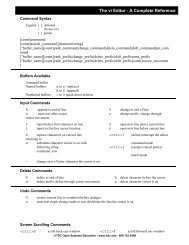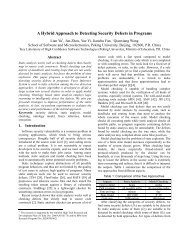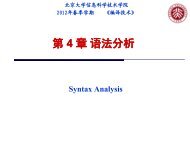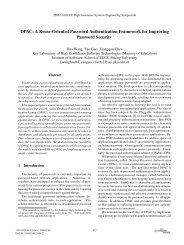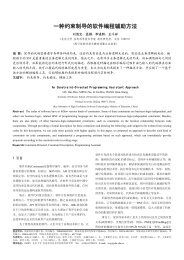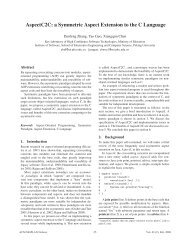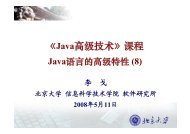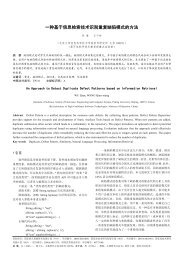Constraint Violation Detection: A Fundamental Part of Software ...
Constraint Violation Detection: A Fundamental Part of Software ...
Constraint Violation Detection: A Fundamental Part of Software ...
You also want an ePaper? Increase the reach of your titles
YUMPU automatically turns print PDFs into web optimized ePapers that Google loves.
<strong>Constraint</strong> <strong>Violation</strong> <strong>Detection</strong>: A <strong>Fundamental</strong> <strong>Part</strong> <strong>of</strong> S<strong>of</strong>tware Cybernetics<br />
Qianxiang Wang<br />
School <strong>of</strong> Electronics Engineering and Computer Science, Peking University, Beijing, China<br />
wqx@pku.edu.cn<br />
Abstract<br />
Monitoring <strong>of</strong> sensitive events is a key step for<br />
controlling the behavior <strong>of</strong> s<strong>of</strong>tware. Specifying a<br />
sufficient set <strong>of</strong> constraints prior to s<strong>of</strong>tware deployment<br />
is necessary for detecting the presence <strong>of</strong> such events<br />
during execution. Here we focus on issues related to<br />
service level constraintsincluding types <strong>of</strong> constraints,<br />
the runtime structure <strong>of</strong> constraints and the related<br />
entities. An experiment to assess the feasibility <strong>of</strong> the<br />
proposed approach is also reported.<br />
1. Introduction<br />
S<strong>of</strong>tware cybernetics views s<strong>of</strong>tware as a new type <strong>of</strong><br />
controlled object [1]. Similar with Autonomic Computing<br />
[2], monitoring <strong>of</strong> sensitive events is a key step for<br />
controlling the behavior <strong>of</strong> s<strong>of</strong>tware. Specifying a<br />
sufficient set <strong>of</strong> constraints prior to s<strong>of</strong>tware deployment<br />
is necessary for detecting the presence <strong>of</strong> such events<br />
during execution. Several researchers have addressed the<br />
problem <strong>of</strong> monitoring sensitive events [3] [4] [5]. The<br />
key belief <strong>of</strong> this paper is that if s<strong>of</strong>tware can detect<br />
sensitive events automatically, and as early as possible,<br />
then it can take appropriate actions, thus avoid many<br />
potential disasters, and improve performance.<br />
Zave divided s<strong>of</strong>tware requirements into “functions <strong>of</strong>”<br />
and “constraints on” s<strong>of</strong>tware systems [6]. This division<br />
indicates the importance <strong>of</strong> constraints. However, for<br />
several years, constraint related issues, especially in the<br />
post-requirements phases, have not gained sufficient<br />
attention. While functional requirements are modeled and<br />
implemented as different design and executable modules,<br />
constraints is <strong>of</strong>ten hidden inside the implementation <strong>of</strong><br />
functional modules.<br />
Well-controlled s<strong>of</strong>tware needs support <strong>of</strong> flexible<br />
structure. In recent years, not only in area <strong>of</strong> s<strong>of</strong>tware, but<br />
also in some other areas such as service computing, grid<br />
computing, researchers have attempted to find flexible<br />
structure for a new generation <strong>of</strong> s<strong>of</strong>tware. Component,<br />
middleware, and aspect-oriented programming (AOP) [7]<br />
etc. are potential candidates for this requirement. It is well<br />
known that s<strong>of</strong>tware is divided into functional modules,<br />
such as procedures, objects, components, etc. Within such<br />
a structure, we ask “How can constraints be represented<br />
and used at runtime?” and “Can we obtain a flexible<br />
s<strong>of</strong>tware structure by separating constraints from<br />
modules that represent functional requirements?” This<br />
paper focuses on obtaining answers to these questions.<br />
The basic idea <strong>of</strong> this work is to separate constraints<br />
from functions. We want to do so not only during the<br />
requirements phase, but also during design and execution.<br />
At runtime, we extract the monitoring code (which is<br />
responsible for constraints) from different procedures and<br />
use one or more independent interceptors to detect<br />
potential constraint violations. An interceptor can<br />
intercept the request messages from a client to a server as<br />
well as the response messages from a server to a client,<br />
and evaluate whether or not any constraint is violated.<br />
These interceptors form a flexible interface to the<br />
functional modules <strong>of</strong> the s<strong>of</strong>tware analogous to the<br />
relationship <strong>of</strong> the knuckles to the bones <strong>of</strong> a body.<br />
The remainder <strong>of</strong> the paper is organized as follows.<br />
Section 2 introduces different types <strong>of</strong> service level<br />
constraints. Section 3 introduces how constraints are used<br />
during the execution <strong>of</strong> a s<strong>of</strong>tware application. Section 4<br />
reports an experiment conducted to investigate the<br />
feasibility <strong>of</strong> the proposed approach. Section 5 points to<br />
related work. Section 6 concludes this paper with our<br />
ideas for further work in this area.<br />
2. What is Service Level <strong>Constraint</strong>s?<br />
There are several types <strong>of</strong> constraints that are strongly<br />
related with sensitive events that need to be monitored.<br />
Examples <strong>of</strong> such constraints are: device, process,<br />
memory, communication, etc. [8]. This paper focuses on<br />
service level constraints. We believe service level<br />
constraints belong to one type <strong>of</strong> most important<br />
constraints <strong>of</strong> s<strong>of</strong>tware. And requests from clients trigger<br />
most <strong>of</strong> the sensitive events in application, directly or<br />
indirectly. A corrective action is needed when a violation<br />
<strong>of</strong> a constraint <strong>of</strong> the type mentioned earlier is detected.<br />
Different types <strong>of</strong> events will likely correspond to<br />
different corrective actions. For example, some event<br />
may be more critical than the others and hence might<br />
require urgent action while for the others the action could<br />
be delayed.
We classify service level constraints into different<br />
types along two orthogonal dimensions. Figure 1 lists the<br />
classification and some examples.<br />
Request<br />
Response<br />
Parameter<br />
related<br />
Value Region<br />
Client context<br />
Value Region<br />
Server context<br />
Time<br />
related<br />
Invocation<br />
order<br />
Response<br />
time<br />
Pattern<br />
related<br />
Error input<br />
ratio<br />
Error output<br />
ratio<br />
Others<br />
Client<br />
number<br />
Response<br />
precision<br />
Figure 1. Different kinds <strong>of</strong> Service Level <strong>Constraint</strong>s<br />
It is easy to see that violations <strong>of</strong> any <strong>of</strong> the constraints<br />
<strong>of</strong> the types listed above are detectable. This paper does<br />
not address semantic issues, or other service level<br />
constraints that have little relationship with s<strong>of</strong>tware, for<br />
example, the cost <strong>of</strong> invocation.<br />
During development, we use an independent file to<br />
describe constraints and related action rules <strong>of</strong> the<br />
application while the remaining files are used to describe<br />
the functions <strong>of</strong> the s<strong>of</strong>tware application. Descriptions to<br />
constraints are usually written after the code for the<br />
functions has been written.<br />
One basic issue arises when constraints are separated<br />
from functions: What is the relationship between<br />
constraints and functions? Can we separate constraints<br />
from functions, just as one separates s<strong>of</strong>tware from<br />
hardware? Is it one high level entity as the control function<br />
in Figure 2 shows?<br />
Control and<br />
Depend on<br />
S<strong>of</strong>tware<br />
<strong>Constraint</strong> and rule<br />
Function code<br />
Hardware<br />
Figure 2. Vision <strong>of</strong> constraint and rule<br />
3. Structure <strong>of</strong> runtime entities<br />
Many current systems are too complex to allow precise<br />
prediction <strong>of</strong> their behaviors. Our solution to this problem<br />
is splitting the traditional implementation <strong>of</strong> a s<strong>of</strong>tware<br />
application into a set <strong>of</strong> functional entities and a set <strong>of</strong><br />
constraint entities. This split makes the s<strong>of</strong>tware easy to<br />
understand and adjust. The main runtime structure <strong>of</strong> a<br />
s<strong>of</strong>tware component is illustrated in Figure 3. From Figure<br />
3 we find that each component has two kinds <strong>of</strong> interfaces:<br />
1) interfaces (left) by which clients propose their request<br />
to that component; and 2) interfaces (upper) for<br />
management by which the administrator or the application<br />
itself can obtain internal application behavior and send<br />
adjustment instructions to the application.<br />
Our work is based on J2EE compliant application<br />
server [9]. The application that runs on a J2EE compliant<br />
application server is composed <strong>of</strong> one or more<br />
components. In a traditional implementation, a<br />
component is an independent module that performs some<br />
specific function(s). In the proposed approach, a<br />
component performs not only some function(s), but may<br />
also check for constraint violation. Functions are<br />
managed by a methods manager, while constraints are<br />
managed by an interceptor manager.<br />
Interface to<br />
client<br />
Administrator<br />
Interceptor<br />
Manager<br />
Interceptor<br />
Rule Engine<br />
Interceptor<br />
……<br />
Interceptor<br />
Method Manager<br />
Method 1<br />
Method 2<br />
……<br />
Method n<br />
Figure 3. Runtime entities from view <strong>of</strong> component<br />
Interceptor is a widely adopted design pattern similar<br />
to the Chain <strong>of</strong> Responsibility pattern from the Gang <strong>of</strong><br />
Four (GoF) [10]. S<strong>of</strong>tware systems, especially loosely<br />
coupled s<strong>of</strong>tware, use the interceptor pattern to enhance<br />
their flexibility and extensibility. For example, most ORB<br />
products use it to enhance security services; some web<br />
servers (such as Apache) use it to allow modules to<br />
register special handlers with the core server; some<br />
application servers (such as JBoss, PKUAS) use it to<br />
provide customized common services such as<br />
transactions, security, etc.<br />
We use interceptors to verify service level constraints.<br />
Interceptors can extract constraint-related information<br />
and check against the predefined constraints. An<br />
interceptor manager ensures the independence <strong>of</strong><br />
constraints during execution. As with the methods<br />
manager, an interceptor resides between the client and the<br />
server. All request messages from the client to the server<br />
and all response messages from the server to the client are<br />
intercepted by the interceptor. The interceptor can<br />
un-marshal the messages and then analyze their content.<br />
If necessary, it can modify the content <strong>of</strong> messages. After<br />
having analyzed (and potentially modified) the message,<br />
the interceptor forwards it to its intended target. We use<br />
multiple interceptors to implement different constraints.
These interceptors can be grouped as one interceptor chain,<br />
and managed by the interceptor manager.<br />
A rule engine receives sensitive events and returns the<br />
corresponding action instructions. In this work, a rule<br />
assumes the form “IF condition THEN action”. A rule<br />
engine maintains a table <strong>of</strong> rules. Conditions are<br />
expressions <strong>of</strong> events, or expressions <strong>of</strong> events,<br />
state-related sub-conditions, and Boolean connectors such<br />
as AND, OR, and NOT. Actions are related directly to<br />
operations. However, most operations for controlling are<br />
used to change parameters <strong>of</strong> the entire s<strong>of</strong>tware system;<br />
other operations can be wrapped within parameter-based<br />
operations. Rule engine is independent <strong>of</strong> the functional<br />
component so that it can resolve rule conflicts across the<br />
functional components. The potential conflict between<br />
different interceptors should be avoided by some policy<br />
checking mechanism before the interceptors are deployed.<br />
The captured event is possibly sent to the rule engine.<br />
The rule engine is responsible for searching whether one<br />
or more rules are triggered by this event. If some rule is<br />
triggered, then the rule engine sends one request to some<br />
runtime entity to adjust the s<strong>of</strong>tware. For example, the<br />
adjustment could be to increase instance number,<br />
disconnect client, redeploy (reboot) some component, etc.<br />
As mentioned before, some constraints are also adjustable,<br />
for example, the maximum number <strong>of</strong> the concurrent<br />
clients.<br />
4. Experiment<br />
As an example, let’s consider we have a Java class<br />
ShoppingCart which is responsible for a web-based<br />
shopping process. Figure 4 lists the interface <strong>of</strong><br />
ShoppingCart. For the sake <strong>of</strong> clarity, we list only the<br />
methods related the constraints <strong>of</strong> this class. These<br />
methods are “addItem()”, “setClientInfo()” and<br />
“checkout()”.<br />
Interface public class ShoppingCart {<br />
public Integer addItem(Integer n, String p);<br />
public void setClientInfo(String info);<br />
public Double checkout();<br />
……<br />
}<br />
Figure 4. The interface <strong>of</strong> ShoppingCart<br />
The constraints <strong>of</strong> class ShoppingCart include:<br />
C1: In the method “addItem()”, the first parameter<br />
represents the number <strong>of</strong> added items, which must be<br />
larger than 0.<br />
C2: The method “addItem()”returns the value <strong>of</strong> total<br />
count, which must be larger than 0.<br />
C3: The method “checkout()”returns the value <strong>of</strong> the<br />
total price which must be larger than 0.<br />
C4: When the client checkout, he/she must have added<br />
some product in the shopping cart and must have filled in<br />
the necessary information such as credit card number,<br />
mailing address, etc. Hence, only when the methods<br />
“addItem()” and “setClientInfo()” have been executed at<br />
least once, can the method “checkout()” be executed.<br />
Furthermore, “checkout” can not be executed twice in a<br />
sequence, which is a miss-operation by the client.<br />
We implemented our approach on the JBOSS-AOP<br />
[20] platform that provides the basic interceptor<br />
infrastructure. We used version 1.0RC2 <strong>of</strong> JBOSS-AOP<br />
which is a standalone version and is independent <strong>of</strong><br />
JBOSS-AS.<br />
Although our system directly uses most <strong>of</strong> the<br />
JBOSS-AOP’s infrastructure, it extends JBOSS-AS as<br />
follows. (1) We import one initial implementation <strong>of</strong> the<br />
rule engine which is responsible for constraint violation<br />
handling; (2) Additional exceptions are defined.<br />
Because our current focus is on constraints, the<br />
implementation <strong>of</strong> the rule engine is relatively simple.<br />
Our primary interest is in investigating the organization<br />
<strong>of</strong> the interceptor chain, so as to give some guidance to<br />
organizing interceptors for different constraints.<br />
The basic platform we used is a PC with Pentium 4<br />
CPU (1.48GHZ), 768MB <strong>of</strong> RAM. We use the above<br />
shoppingCart example to observe the time needed to use<br />
the interceptors.<br />
To compare time delays under different situations, all<br />
functional code is set to empty. We observe relationships<br />
between time and the number <strong>of</strong> interceptors. We also<br />
observe the time taken by an interceptor depends on<br />
constraint violation. The experimental data is listed in<br />
Figure 5.<br />
Interceptor No<br />
C2 Violated C4 Violated<br />
Number violation<br />
4 94.8 34.4 73.9<br />
3 71.2 25.5 57.3<br />
2 49.4 18.2 42.5<br />
1 25.3 8.9 24.0<br />
Figure 5. Time cost <strong>of</strong> interceptors (10 -6 second)<br />
Four interceptors were generated for each constrains<br />
type. The sequence <strong>of</strong> interceptors is: {C4}, {C1}, {C2},<br />
{C3}. Row 2 corresponds to two interceptors for output<br />
parameter constraints merged. The sequence <strong>of</strong><br />
interceptors is: {C4}, {C1}, {C2, C3}. In row 3, all<br />
interceptors for parameter constraints were merged<br />
together. The sequence <strong>of</strong> interceptors is: {C4}, {C1, C2,<br />
C3}. In row 4, we use one interceptor (see Figure 3) to<br />
check all four constraints.<br />
Data in column 1, we call three methods addItem(),<br />
setClientInfo() and checkout() in sequence, and no<br />
violation occurred. In column 2, the constraint for output<br />
parameter <strong>of</strong> first method addItem() is violated and hence
only additem() is invoked. In column 3, we call a wrong<br />
method in the wrong invocation order: addItem(),<br />
addItem() and checkout(). When checkout() is called, only<br />
the first constraint C4 is checked, because it is the first<br />
constraint in the constraint sequence and is violated.<br />
From the experimental data shown we observe that,<br />
merging related interceptors can reduce time overhead.<br />
The time decreases almost linearly both in the case <strong>of</strong> no<br />
violation and in the case <strong>of</strong> some constraint violation.<br />
Nevertheless, it is to be noted that merging too many<br />
constraints reduces flexibility and makes the automatic<br />
generation <strong>of</strong> interceptors difficult.<br />
5. Related Work<br />
Dynamic AOP, such as JAC [11], AspectWerkz [12]<br />
and Prose [13] weave aspects at runtime. This approach<br />
provides a powerful solution to the problem application<br />
modification by changing the aspects currently woven and<br />
weaving new aspects while the application is running. Our<br />
current runtime constraint entities are implemented by one<br />
AOP platform JBOSS-AOP. Although the concept<br />
“aspect” comes from programming and that concept<br />
“constraint” comes from requirement, we find that the two<br />
are strongly related. Most constraints can be implemented<br />
using aspects. However, an accurate relationship between<br />
aspect and constraint remains unclear.<br />
Feng Chen et al. [5] proposed Monitoring Oriented<br />
Programming (MOP) approach, which insert constraints<br />
at critical places, and automatically synthesize and embed<br />
monitoring code in the functional procedures. Kim et al.<br />
[14] designed Java-MaC, which inserts probe “filter” into<br />
the target program, keeps track <strong>of</strong> changes <strong>of</strong> monitored<br />
objects, and sends pertinent state information to the event<br />
recognizer. Compared with interceptor based approach,<br />
embedded approach is more efficient. But when facing<br />
runtime reconfiguration which is important to autonomic<br />
systems, interceptor based approach is more flexible.<br />
6. Conclusion<br />
This paper describes our initial effort towards service<br />
level constraints violation detection. We attempted to<br />
explore service level constraints and keep them relatively<br />
independent at runtime and design time, so as to detect<br />
sensitive events automatically, and as early as possible.<br />
Acknowledgments<br />
This paper is supported in part by the National<br />
High-Tech Research and Development Plan <strong>of</strong> China No.<br />
2003AA115430 and the National Grand <strong>Fundamental</strong><br />
Research Program <strong>of</strong> China No. 2002CB31200003.<br />
Thanks Pr<strong>of</strong>essor Aditya P. Mathur, for hosting the author<br />
at Purdue University and for providing so much help in the<br />
preparation <strong>of</strong> this paper.<br />
References<br />
[1] Kai-Yuan Cai, Joao W. Cangussu, Ray A. Decarlo and<br />
Aditya P. Mathur, An Overview <strong>of</strong> S<strong>of</strong>tware<br />
Cybernetics, Eleventh Annual International Workshop<br />
on S<strong>of</strong>tware Technology and Engineering Practics,<br />
2003.<br />
[2] Jeffrey Kephart, David Chess, The vision <strong>of</strong><br />
Autonomic Computing, IEEE Computer, January 2003.<br />
[3] Emre Kýcýman, Yi-Min Wang, Discovering<br />
Correctness <strong>Constraint</strong>s for Self-Management <strong>of</strong><br />
System Configuration, International Conference on<br />
Autonomic Computing (ICAC'04), May 17-18, 2004,<br />
New York, NY, USA.<br />
[4] David Garlan, Bradley Schmerl, and Jichuan Chang,<br />
Using Gauges for Architecture-Based Monitoring and<br />
Adaptation, Working Conference on Complex and<br />
Dynamic Systems Architecture, Brisbane, Australia,<br />
12-14 December, 2001.<br />
[5] Feng Chen, Grigore Rosu, Towards<br />
Monitoring-Oriented Programming: A Paradigm<br />
Combining Specification and Implementation, third<br />
workshop on Runtime Verification, 2003.<br />
[6] P. Zave, “Classification <strong>of</strong> Research Efforts in<br />
Requirements Engineering”, In proceedings <strong>of</strong> the 2nd<br />
IEEE International Symposium on Requirements<br />
engineering (RE95), York, England, 1995.<br />
[7] Gregor Kiczales, John Lamping, Anurag Mendhekar,<br />
Chris Maeda, Cristina Videira Lopes, Jean-Marc<br />
Loingtier, John Irwin, Aspect-Oriented Programming,<br />
In proceedings <strong>of</strong> the European Conference on<br />
Object-Oriented Programming (ECOOP), Finland. June<br />
1997.<br />
[8] Sandeep Neema, Ákos Lédeczi: <strong>Constraint</strong>-Guided<br />
Self-adaptation, Second International Workshop on<br />
Self-Adaptive S<strong>of</strong>tware, IWSAS, 2001.<br />
[9] SUN, J2EE Specification, http://java.sun.com/j2ee.<br />
[10] E. Gamma, R. Helm, R. Johnson, and J. Vlissides,<br />
Design Patterns: Elements <strong>of</strong> Reusable<br />
Object-Oriented S<strong>of</strong>tware, Addison-Wesley, 1995.<br />
[11] Popovici, A., Gross, T., Alonso, G., “Dynamic<br />
Weaving for Aspect-Oriented Programming”, 1st<br />
International Conference on Aspect-Oriented<br />
S<strong>of</strong>tware Development, 2002. Enschede, Netherlands.<br />
[12] AspectWerkz, “AspectWerkz Overview”,<br />
http://aspectwerkz.codehaus.org/, 2003.<br />
[13] Popovici, A., Gross, T., Alonso, G., “Dynamic<br />
Weaving for Aspect-Oriented Programming”, 1st<br />
International Conference on Aspect-Oriented<br />
S<strong>of</strong>tware Development (AOSD 2002), 2002. Enschede,<br />
Netherlands.<br />
[14] Moonjoo Kim, Sampath Kannan, Insup Lee, Oleg<br />
Sokolsky, Java-MaC: a Run-time Assurance Tool for<br />
Java, 1st International Workshop on Run-time<br />
Verification. Paris, France, July, 2001.




